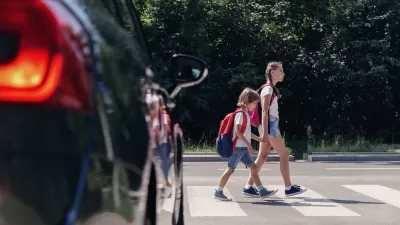As home delivery of everything from groceries to furniture becomes more popular, policymakers must evaluate how to keep streets safe and accessible for pedestrians and other vulnerable users.

In a piece on NJfuture.org, Tim Evans ponders the role of goods delivery in the Complete Streets model. "How should we be thinking about the safety of pedestrians and other non-motorized travelers in an era of increasing truck traffic?," Evans asks.
In New Jersey, goods movement is a major industry, accounting for one in eight jobs. Meanwhile, the growth of e-commerce, accelerated by the pandemic, has led to a sharp rise in delivery services and truck traffic. "In recognition of the increasing visibility of freight movement on New Jersey’s highways, roads, and streets, the Federal Highway Administration (FHWA) and the New Jersey Department of Transportation (NJDOT) recently hosted a workshop entitled 'Freight in our Neighborhoods: Toward a More Complete Street.'"
While some may question why 'complete streets' would even include trucks, the reality is that deliveries must happen. But "Introducing large trucks onto local streets that were designed for smaller vehicles, and where pedestrians are frequently present, creates numerous problems." To that end, "The purpose of the FHWA/NJDOT workshop was to raise the issue of how to balance the need to deliver goods to people and local businesses with the needs of other users of local streets, particularly those not inside vehicles."
Evans outlines the different options that delivery services and cities have for accommodating new demand for home delivery while maintaining safe, accessible streets for all users. "Rather than proposing truck-focused modifications (wider lanes, bigger turning radii, etc.) to local streets in order to accommodate truck deliveries, transportation planners and logistics industry professionals should focus instead on matching the type of delivery vehicle to the environment in which the destination is located."
"If goods are increasingly being shipped directly to people’s homes rather than changing hands at suburban retail complexes to which people drive their own vehicles, then local streets need to be prepared to accommodate delivery vehicles in addition to private automobiles." Even smaller vehicles will need space to stop and make deliveries, writes Evans.
As Complete Streets advocates make their case for improving pedestrian safety and addressing the needs of diverse road users, "The relatively recent increase in the popularity of home delivery means that addressing freight movement on local streets is very much a live issue."
FULL STORY: “Complete Streets” and Goods Delivery: What Is a Street For?

Alabama: Trump Terminates Settlements for Black Communities Harmed By Raw Sewage
Trump deemed the landmark civil rights agreement “illegal DEI and environmental justice policy.”

Planetizen Federal Action Tracker
A weekly monitor of how Trump’s orders and actions are impacting planners and planning in America.

The 120 Year Old Tiny Home Villages That Sheltered San Francisco’s Earthquake Refugees
More than a century ago, San Francisco mobilized to house thousands of residents displaced by the 1906 earthquake. Could their strategy offer a model for the present?

In Both Crashes and Crime, Public Transportation is Far Safer than Driving
Contrary to popular assumptions, public transportation has far lower crash and crime rates than automobile travel. For safer communities, improve and encourage transit travel.

Report: Zoning Reforms Should Complement Nashville’s Ambitious Transit Plan
Without reform, restrictive zoning codes will limit the impact of the city’s planned transit expansion and could exclude some of the residents who depend on transit the most.

Judge Orders Release of Frozen IRA, IIJA Funding
The decision is a victory for environmental groups who charged that freezing funds for critical infrastructure and disaster response programs caused “real and irreparable harm” to communities.
Urban Design for Planners 1: Software Tools
This six-course series explores essential urban design concepts using open source software and equips planners with the tools they need to participate fully in the urban design process.
Planning for Universal Design
Learn the tools for implementing Universal Design in planning regulations.
Clanton & Associates, Inc.
Jessamine County Fiscal Court
Institute for Housing and Urban Development Studies (IHS)
City of Grandview
Harvard GSD Executive Education
Toledo-Lucas County Plan Commissions
Salt Lake City
NYU Wagner Graduate School of Public Service





























